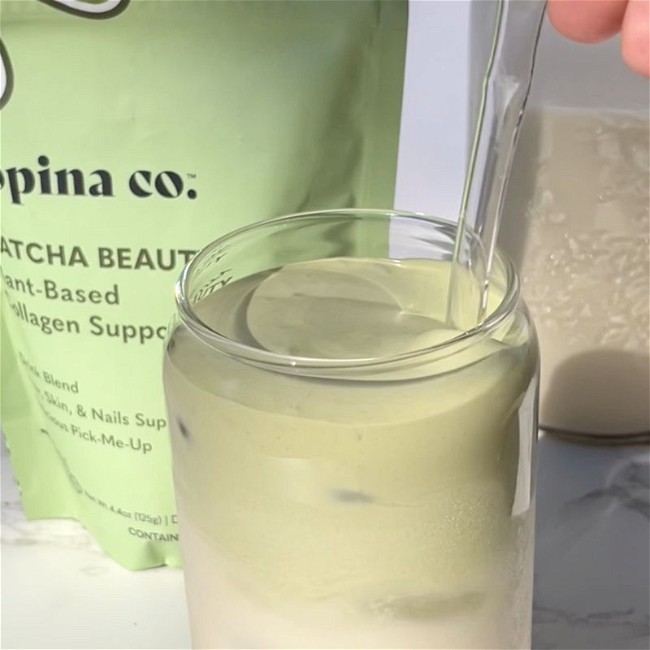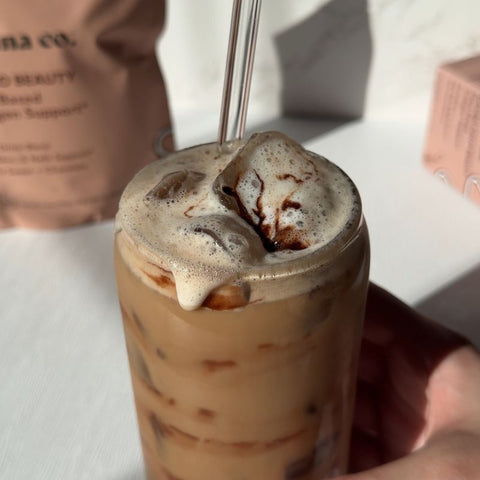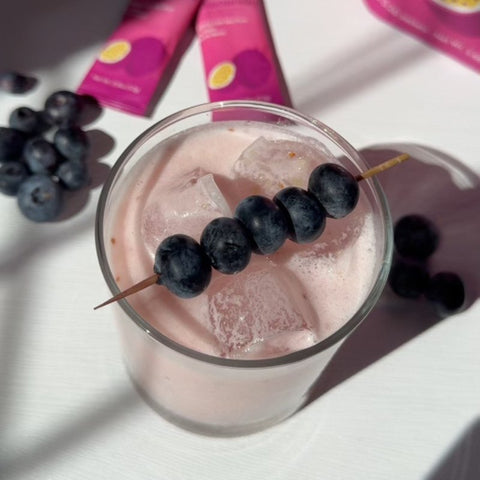We love making this whipped-coffee inspired matcha latte on days where we want our latte to be a little thicker. It's naturally a little sweet already thanks to our matcha vegan collagen blend, but the whipping cream + a dash of vanilla makes it even more special.
This latte is super easy to whip up, especially if you have the Copina Co. whisk handy. Our handheld whisk makes the best foam and forth for all types of lattes and drinks.
In order to make this beauty-boosting matcha whip all you will need is one scoop or one stick pack of our matcha vegan collagen support, plant-based whipping cream or creamer, almond milk, and any sweetener you might crave. This might include stevia, maple syrup, or agave. We recommend tasting our matcha blend first, to know how much (or little) you might want to add! Our matcha vegan collagen support is sweetened with monk fruit and is a great zero sugar alternative to many store-bought matcha lattes that are loaded with sugars and syrups.
One all the above is in a tall glass, you can begin whipping with our whisk until it looks nice and thick. Add ice to a glass, add in enough milk to cover you ice, and layer your whipped matcha on top. Stir to combine, and enjoy! It is that easy and delicious.
Although we love making matcha lattes and other trendy new recipes, we do love learning about the heritage and history the matcha plant comes from. Our CEO has even traveled to Japan to visit our matcha supplier and learn more about matcha!
One amazing detail we like to highlight about the trip: matcha is grown in the shade! That’s right, the field in the pictures (behind Carolyn) is covered with shade a month before May harvest time to increase chlorophyll and l-theanine of the sweet and delicate matcha that we use in our vegan collagen support matcha blend. We feel so grateful to get to see how our matcha is grown and cultivated for our matcha blend, here are some other fun things we learned during our time in Japan.
Something you might not know is that steeped green tea and matcha tea are actually from the same plant! What makes them different is how they are cultivated and processed. One of the differences is that matcha leaves are grown in the shade for the last growing cycle, whereas green tea leaves are not. During this growing cycle, matcha leaves turn color into a bright jade green due to the shading process. Matcha in Japan is typically harvested in May, so for about 30 days starting in early April, the matcha tea plants get shades stretched over them. Some companies use a dark black screen and others use a bamboo screen, but both accomplish the same result: increasing the chlorophyll content of the matcha leaves. It also increases the l-theanine of the matcha leaves and gives them a sweeter, more mild flavor than regular green tea. Another benefit of a matcha latte!
While the shading process takes place, the best matcha growers will actually suspend the shades so the matcha plant’s leaves do not get damaged as matcha leaves are very delicate. Some ingredient-grade matcha growers will put the shade down directly on the leaves which can lead to some damage or reduction in quality. Also since matcha leaves are so delicate they are often hand-picked so the leaves stay whole and undamaged.
If you want to learn more about how we personally make our Matcha and Matcha Collagen Lattes we have a collection on Tik Tok:
- How to Make Matcha with 0 grams of Sugar
- Talking Matcha Grades
- How to Spot a Good Matcha
- How to Make A Collagen Boosting Matcha Latte
- 3 Tips for Buying Matcha
- Skin Friendly Matcha Latte
- How to Make a Vegan Matcha Latte
Enjoyed this recipe? You'll love some of our other fun latte & drink recipes.
- Vegan Strawberry Piña Colada
- Blueberry Jam Matcha Latte
- Raspberry Hibiscus Latte
- Matcha Lemonade
- Collagen-Boost Chocolate Milk














